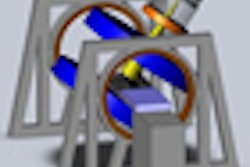Stereotactic body radiation therapy (SBRT) yields excellent cancer-free survival rates for intermediate-risk, organ-confined prostate cancer patients and results in few long-term rectal side effects, according to research presented at the American Society for Radiation Oncology (ASTRO) annual meeting.
Lead author Dr. Robert Meier, a radiation oncologist with the Swedish Cancer Institute in Seattle, reported an interim analysis of the phase II, prospective, multi-institutional study that closed its accrual in 2011. Supported by an educational grant from radiation oncology firm Accuray, the study evaluated the toxicity and efficacy of SBRT in 129 intermediate-risk, organ-confined prostate cancer patients, in addition to examining patient quality of life.
The study included patients treated at one of 21 hospitals from 2007 to 2010. The patients had a median prostate-specific antigen (PSA) level of 5.9 ng/mL before beginning treatment.
All patients were treated with a nonisocentric robotic SBRT platform using real-time tracking of implanted fiducial markers. MRI was used to assist in target localization. SBRT was administered to patients at 40 Gy in five fractions of 8 Gy to the prostate, and 36.25 Gy was delivered to seminal vesicles. No patient was prescribed androgen-deprivation therapy.
At a median follow-up of 30 months, only one patient had experienced a recurrence, with a biopsy-proven nodal metastasis diagnosed three months after treatment. Median PSA declined to 0.80 ng/mL at one year following treatment, 0.38 ng/mL at two years, and 0.20 ng/mL at three years. The three-year Kaplan-Meier biochemical progression-free survival rate for the patient cohort was 99.2%.
None of the patients experienced acute grade 3 or worse toxicities. However, acute grade 2 genitourinary and gastrointestinal toxicities occurred in 23% and 8.5% of patients, respectively. Fourteen patients (11%) experienced late grade 2 genitourinary toxicities, and three (2%) experienced late grade 2 gastrointestinal toxicities. One patient had a grade 3 bladder neck injury one year after treatment.
Patients completed Expanded Prostate Cancer Index Composite (EPIC-26) questionnaires for urinary, bowel, and sexual function. Mean EPIC urinary and bowel scores fell at one month following treatment, but they returned to baseline levels within two years.
Sexual function, however, declined. Prior to treatment, more than half of the patients (52%) reported being potent. Two years following treatment, only 36% reported that they still were.
Older men with intermediate-risk, organ-confined prostate cancer are at risk for progression and spread of the disease, which becomes more difficult to treat, Meier said.
"Our study demonstrates very promising cancer control rates and few side effects," Meier said. "With further research and longer follow-up assessments, it may be possible for patients to undergo a much shorter treatment schedule of just one week of SBRT as opposed to the standard eight- to nine-week course of treatment needed with other radiation methods."



















